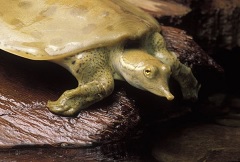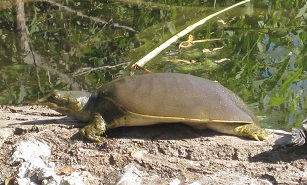Gulf Coast Smooth Softshell Turtle (Apalone mutica calvata)
Description: The soft, leathery shell of softshell turtles makes them resemble pancakes with legs. All species have long necks and heads, ending in a snorkel-like nose. The rear feet of these powerful swimmers are strongly webbed. Smooth softshell lacks spines, bumps or sandpapery projections on front edge of upper shell (carapace), and nasal septum
(dividing membrane between nostrils) lacks ridges. Carapace is olive-gray to brown and typically marked with large spots that may fade in adults, especially females. Lower shell (plastron) pale, top of snout unstriped, feet without pronounced markings. Females may reach 10 inches in shell length , males 7 incges.
Habitat: Rivers and large streams; commonly buries itself underwater along edges of and within shallowly inundated sandbars, where it uses its long neck and nose to reach the surface for air.
Range: The Gulf Coast smooth soft shell turtle has a range that extends from the panhandle of Florida to Louisiana. Not a lot of information is available, but the turtle is known to inhabit the Pearl, Alabama, and Escambia River systems. Found in the western portion of the Coastal Plain.
Found in these States:
AL |
FL |
LA |
MS
Diet: Although mostly carnivorous, smooth softshell turtles also consume some plant materials. They are an ambush predator using their long neck to grab passing prey while lying concealed in the substrate. They also are known to hunt out of water using the same technique and to use their nose to find food hidden in the substrate. Females generally will hunt in deeper waters, while the males will utilize the shallow waters near the shore.
Reproduction: Breeding in this species is believed to occur in April to June. One to three clutches can be laid with up to 33 eggs. Clutches produced in the later times of the season usually contain fewer eggs. Nests are usually located on sand bars with little or no vegetation within 55 feet of the water's edge. The female will usually burrow a tunnel and place herself at the opposite end of the nest. Eggs will hatch in 8 to 12 weeks after they are laid. The young are precocial once they have hatched. Males and females become sexually mature during their fourth and ninth year, respectively.
Status: Apalone mutica is a reasonably widespread, fairly cryptic, and locally common species with high reproductive potential by turtle standards. Extensive areas of suitable habitat exist and are likely to remain for the foreseeable future. Harvest rates appear not significant enough to have led to documented localised declines. Nevertheless, this assessment is more an issue of lack of data documenting a decline than available data indicating stable populations; population monitoring is highly desirable as the species can be argued to warrant Near Threatened. It is however currently listed as Least Concern.
»» Kingdom: Animalia - Animals
»» Phylum: Chordata - Chordates
»» Subphylum: Vertebrata - Vertebrates
»» Class: Reptilia - Reptiles
»» Order: Testudines - Turtles & Tortoises
»» Family: Trionychidae - Softshell Turtle
»» Genus: Apalone
»» Species: Apalone mutica - Smooth Softshell Turtle
»» Subspecies:
»» Gulf Coast Smooth Softshell Turtle - ( Apalone mutica calvata)
This article uses material from the Wikipedia article "Smooth Softshell Turtle", which is released under the Creative Commons Attribution-Share-Alike License 3.0. Content may have been omitted from the original, but no content has been changed or extended.
|












